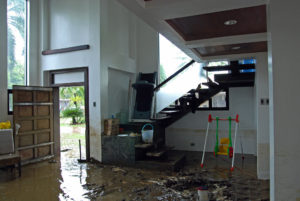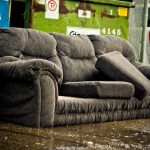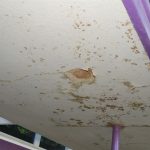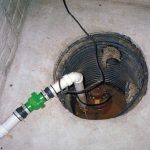If you own a home, there are many steps to take, both big and small, to prevent flooding in your home. But before taking these steps below, it is important to assess the flood risk in your geographical area. Simply type in your address on FEMA’s (Federal Emergency Management Agency) flood maps and you can identify your flood risk and whether you are in a low, medium, or high-risk area.
After determining your geographical flood risk, you may want to customize your flood prevention plan accordingly.

Determine Your Risk of Flooding
You will also want to note the date on the maps, as some of them are severely outdated. So of course, the flood risk will change over time and the actual risk in your area will be different than what is reflected on the map.
You will also want to discuss with your insurance adjuster or agent the specific flood level of your home. The flood level is considered the height at which flood water may rise during severe weather. But your home should be built on a slight slope to allow water to flow away from your home to prevent flood damage.
You will also want to note where flood waters may enter your home by inspecting the surface runoff during the next snowmelt or rainstorm. Also determine if the water flows away or towards the home, as well as any specific doors or basement windows in which flood waters may enter. This will also help to assess overall risk and determine if you may need to re-landscape your yard.
Finally, if you are located in a flood zone, it’s important to consider investing in flood insurance as standard homeowner’s insurance doesn’t cover flooding. Flood insurance can be purchased in addition to your homeowner’s policy or directly from the National Flood Insurance Program.
Tips to Prevent Flooding in Your Home
After determining your home’s overall risk of flooding, it is important to take all necessary steps to keep your home dry during the rainy seasons. These steps can range from free, basic maintenance to expensive home repairs, however, each will depend on your overall risk of flooding as well as how well the home was built to withstand flooding.
Renovations to Prevent Flooding
If your home was not built to resist water and is located in a flood-prone area, it’s crucial to take the following steps to protect your home and belongings. Here are some home renovations to maintain flood control and prevent standing water.
- Apply sealants and coatings. There are “dry flood-proofing” coatings and sealants available for purchase that you can apply to your walls, windows, doorways, and foundation. This will help to prevent floodwater from leaking through the cracks.
- Install a sump pump or foundation vents. Foundation vents are a form of “wet flood-proofing” to allow flood water to flow throughout the home rather than pool around it. The vents will create an outlet for floodwater to flow out the home, relieving significant water pressure from your basement windows and walls. Sump pumps are also handy in pumping water out of basements, which happens regularly. You should consider adding a sump pump battery backup, just in case the power goes out.
- Grade your lawn away from the home. If your home’s foundation doesn’t sit on a slope, water will simply pool around your home and flood your basement. But heavy soil containing clay and/or sand will be helpful to regrade the lawn so the water will run away from the home and into the street gutter.
- Point your downspouts away from the home. If your gutter runoff is pointed toward your home, it will pool around the corners of your home and leak into your basement.
- Add space between your mulch and siding. Wet mulch will lead to rotten siding, which will eventually cause leaks. Add a space between your mulch and siding so the base of the home can dry completely after it rains.
- Install check valves on your pipes. All pipes entering your home should have valves to prevent a sewer backup in your home. It’s preferred to have gate valves rather than flap valves since they are sealed better against flood pressure.
- Raise your home on piers or stilts. As you can imagine this is a costly renovation but doing this will raise the home’s flood level. As just an inch of water can lead to severe structural damage, you will never have to worry if the home is simply raised off the ground.
While it’s important to protect your home and belongings from flood water, interior and exterior appliances must also be protected, or they can be costly to replace. Consider standing them up on concrete blocks to prevent them from becoming submerged in flood water.
- Water heaters
- Dryers
- Generators
- HVAC systems
- Washing machines
Flood Cleanup
There are always numerous steps that can be taken to prevent flood waters from entering your home. But there’s no specific way to fully flood-proof your home. Due to the numerous potential sources commonly known to damage a home, such as burst pipes, leaking pipes and appliances, roof leaks, sewer backups, and natural flooding, it’s simply impossible to fully prevent water damage.
At any point you do find this problem in your home, don’t hesitate to contact a local flood restoration or water damage restoration professional. These companies should always provide 24/7 service and respond right away to limit the damage and restore the building materials as quickly as possible.
As soon as they arrive, they will extract any and all standing water from the property and then set up powerful drying equipment to remove the remaining moisture. Anti-microbials should also be applied to limit mold growth, but if the technicians find mold growth, it should also be removed by a professional. Any soiled porous materials will be removed to inhibit mildew.
Finally, after completing the job, they should work with your insurance agency during the claims process for additional peace of mind. Just be sure to take steps in the future to prevent flood damage from the same source.




